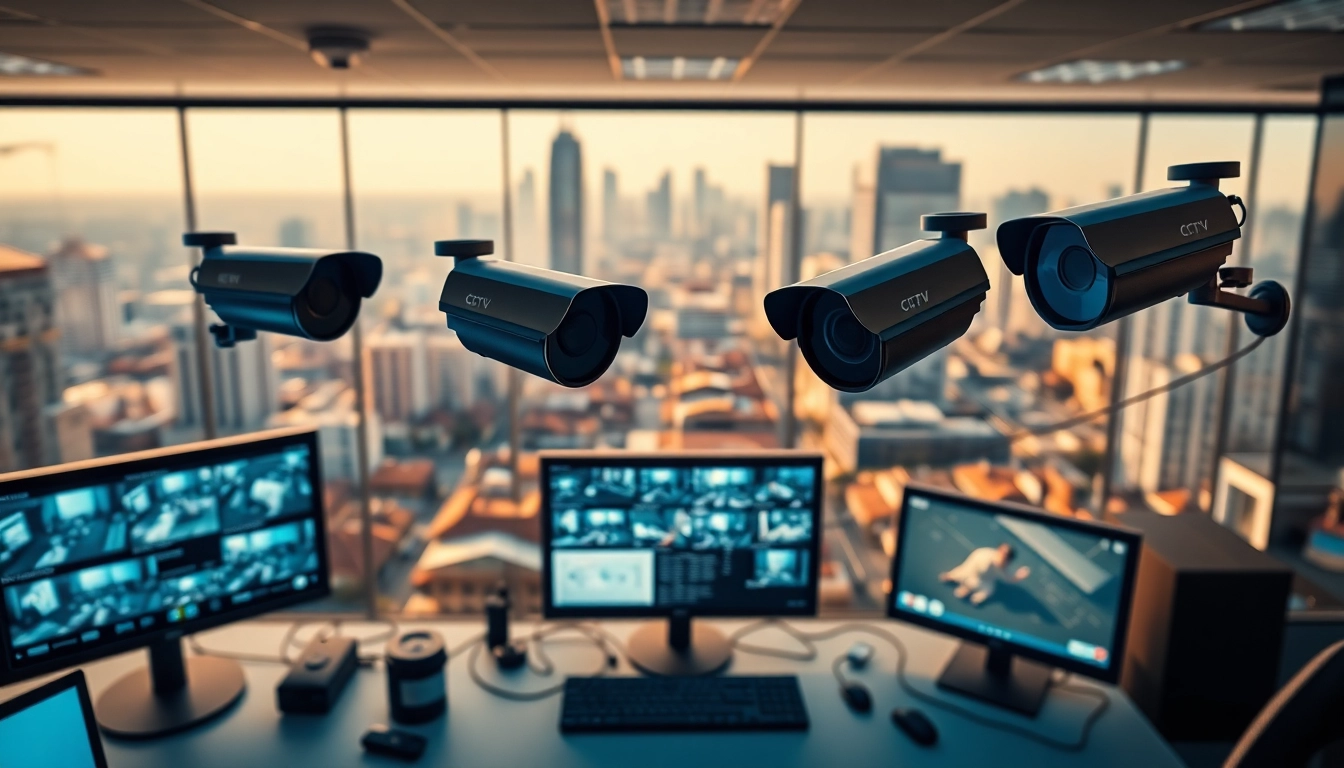Understanding CCTV & Remote Monitoring
What is CCTV & Remote Monitoring?
CCTV, or Closed-Circuit Television, refers to a system that utilizes video cameras to transmit a signal to a specific set of monitors. Unlike broadcasting, which is open to the public, CCTV is a closed system, making it ideal for security purposes. Remote Monitoring is an extension of this system, allowing users to access live or recorded feeds from anywhere using an internet connection. With the rise of technology, CCTV systems have evolved, enabling features such as remote access through smartphone apps and advanced analytics for monitoring behavior and detecting anomalies.
Combining these two technologies, CCTV & Remote Monitoring provides comprehensive surveillance solutions that enhance safety and security in various environments, from residential properties to large enterprises.
The Importance of CCTV & Remote Monitoring in Security
As crime rates fluctuate and the necessity for enhanced security measures becomes critical, CCTV & Remote Monitoring has emerged as a vital component of contemporary security systems. These setups serve not only as a deterrent against potential criminals but also provide substantial evidence in case of incidents. Additionally, they can significantly reduce response times for security personnel, allowing for proactive interventions.
The continuous development in camera technology has further solidified the importance of CCTV systems. High-resolution cameras enable clearer images, while night vision capabilities enhance surveillance effectiveness during low-light conditions. In an era where security threats are increasingly sophisticated, the integration of remote monitoring capabilities allows for immediate access to security feeds, facilitating timely responses and better overall risk management.
How CCTV & Remote Monitoring Works
CCTV systems generally consist of cameras, a recording device, and a monitor. In a standard setup, cameras capture video footage that is sent to a digital video recorder (DVR) or network video recorder (NVR). This footage can be viewed live on monitors or accessed remotely using an internet connection and compatible mobile applications or computers.
Remote monitoring enhances traditional CCTV by transmitting footage over the internet. This allows security personnel or the property owner to monitor live feeds from anywhere, with the ability to receive alerts based on specific events such as motion detection or line crossing. Advanced systems also include features like two-way audio communication, enabling real-time conversation through the camera’s microphone and speaker, further enhancing interaction capabilities.
Types of CCTV & Remote Monitoring Systems
Wired vs. Wireless CCTV & Remote Monitoring
When choosing between wired and wireless CCTV & Remote Monitoring systems, there are several factors to consider. Wired systems typically provide a more stable connection, is less prone to interference, and does not rely on battery life for operation. However, installation can be more complex, requiring physical wiring throughout the premises.
Conversely, wireless systems offer greater flexibility in terms of placement and installation. They are easier to set up and can be integrated seamlessly into existing networks. However, they may experience interference from other wireless devices and require regular battery maintenance. Both types have their pros and cons, and the choice largely depends on the specific needs and layout of the property in question.
Choosing the Right Cameras for CCTV & Remote Monitoring
Selecting the appropriate cameras is crucial to the effectiveness of your CCTV & Remote Monitoring system. Key factors to consider include:
- Resolution: Higher resolution cameras provide clearer image quality, making identification easier in case of an incident.
- Field of View: Cameras with a wide-angle lens can cover larger areas, reducing the number of cameras needed.
- Durability: For outdoor use, cameras should be weatherproof and capable of operating in varying temperatures.
- Night Vision: Infrared capabilities allow for clear footage even in low-light conditions, crucial for nighttime surveillance.
Ultimately, considering the unique requirements of your environment will lead to a more effective security solution.
Integration of Smart Technology in CCTV & Remote Monitoring
Today’s CCTV systems are increasingly incorporating smart technologies aimed at enhancing security and usability. Features such as motion detection, facial recognition, and advanced analytics are becoming commonplace. These systems can learn from previous patterns, recognizing typical movements to distinguish between regular activity and potential threats.
Moreover, integration with smart home systems allows users to control their CCTV & Remote Monitoring setups from their smartphones or smart devices. This convergence offers users new levels of convenience and control, making it easier to manage security on the go. Many systems now support cloud storage, which provides secure off-site data storage and easy accessibility, further enhancing the system’s reliability and functionality.
Benefits of CCTV & Remote Monitoring
24/7 Surveillance and Peace of Mind
One significant advantage of implementing CCTV & Remote Monitoring is the capability for 24/7 surveillance. This continuous monitoring ensures that no matter the time or day, your property is under watch, allowing you to enjoy peace of mind. The knowledge that there are systems in place to detect intrusion or suspicious behavior makes property owners feel more secure.
In addition to enhancing perceived security, constant surveillance can drastically reduce the chances of successful criminal activity. Studies have shown that properties with visible security cameras are often less targeted compared to those without such measures.
Real-Time Monitoring and Incident Response
Real-time monitoring is one of the cornerstone advantages of CCTV & Remote Monitoring systems. The ability to view live feeds allows security personnel to respond immediately to incidents, minimizing damage and addressing security breaches effectively. This capability not only aids in deterring crime but also supports quick responses in emergencies, such as fire alerts or medical incidents.
Moreover, advanced monitoring systems provide alerts based on unusual activities. With features like facial detection and intrusion alerts, property owners or security teams can gain deeper insights into behaviors occurring on-site, allowing for informed decision-making.
Cost-Effectiveness of CCTV & Remote Monitoring
While the initial investment in CCTV & Remote Monitoring may seem significant, the long-term benefits often justify the expense. By mitigating risks associated with theft, vandalism, and other incidents, property owners can significantly reduce insurance premiums and losses related to criminal acts.
Furthermore, the integration of remote monitoring capabilities means that businesses can reduce the need for physical security personnel, as remote operators can monitor multiple locations efficiently. This not only saves valuable resources but also enhances the overall effectiveness of surveillance practices.
Implementing CCTV & Remote Monitoring Systems
Steps to Set Up Your CCTV & Remote Monitoring
Setting up a CCTV & Remote Monitoring system involves crucial steps that must be followed to ensure effective implementation:
- Assess Your Needs: Identify the specific areas that require surveillance and the types of threats you aim to mitigate.
- Select the Right Equipment: Choose cameras and monitoring systems that match your requirements. Consider factors like resolution, night vision, and field of view.
- Plan Camera Placement: Strategically position cameras to cover vulnerable areas while considering blind spots.
- Install and Connect: Follow the manufacturer’s instructions for installation and ensure all devices are properly connected to a power source and network.
- Configure Settings: Set up alerts, recording schedules, and remote access to optimize the use of your monitoring system.
- Test the System: Conduct thorough tests to ensure cameras are functioning correctly and that footage can be accessed remotely without issues.
- Educate Personnel: Ensure all users understand how to navigate the system and respond effectively to any alerts.
By following these steps, property owners can enjoy a robust security setup tailored to their specific needs.
Common Challenges in Implementation
While implementing CCTV & Remote Monitoring systems can significantly enhance security, potential challenges may arise:
- Technical Difficulties: Issues with installation and equipment configuration can result in suboptimal system performance. Engaging professional assistance may mitigate this.
- Privacy Concerns: Surveillance can raise concerns about privacy rights. Ensuring compliance with local laws and regulations is critical to avoid complications.
- Costs: Initial investment and ongoing maintenance costs can be a hurdle for some businesses. However, a well-planned security strategy can yield significant long-term savings.
Addressing these challenges proactively can ensure a smoother implementation process and better overall effectiveness in security measures.
Maintenance Tips for Long-Term Efficiency
To maximize the lifespan and effectiveness of your CCTV & Remote Monitoring system, regular maintenance is paramount. Here are essential tips:
- Routine Inspections: Periodically check camera positions and angles to ensure complete coverage, and adjust as needed.
- Update Software: Keep software and firmware updated to benefit from the latest features and enhancements.
- Clean Cameras: Regularly clean lenses to maintain optimal clarity, especially in outdoor settings.
- Review Footage: Frequently evaluate recorded footage to ensure cameras are functioning correctly and to familiarize with typical activities in the area.
- Test System Regularly: Conduct routine checks to confirm that alerts and monitoring capabilities are operational.
Consistency in maintenance will ensure that your CCTV & Remote Monitoring system remains effective and efficient, providing long-term security solutions.
Future Trends in CCTV & Remote Monitoring
Advancements in AI and Analytics
The future of CCTV & Remote Monitoring is being shaped by advancements in artificial intelligence (AI) and analytics. New systems utilize AI to analyze footage in real-time, enabling them to respond dynamically to detected threats. Facial recognition technology is evolving, allowing for identification of known individuals and potential intruders.
Furthermore, predictive analytics can be employed to assess patterns and predict future criminal activity, providing a proactive approach to surveillance. This modernization shifts monitoring from merely a reactive measure to a strategic defense mechanism.
The Role of Cloud Technology in CCTV & Remote Monitoring
Cloud technology is revolutionizing CCTV systems by offering scalable storage solutions and remote access capabilities. Cloud-based monitoring systems allow users to store large volumes of footage without the constraints of traditional storage systems. This flexibility means users can retrieve, review, and analyze footage from anywhere at any time.
Moreover, cloud technology enables seamless integration with other smart security devices, resulting in a more cohesive and comprehensive security strategy. The capability to store and process data in the cloud ensures that footage is secure, accessible, and easily manageable.
Increasing Importance of Cybersecurity in CCTV & Remote Monitoring
As CCTV & Remote Monitoring systems become more interconnected and reliant on the internet, the emphasis on cybersecurity becomes imperative. Protecting surveillance systems from hacking and unauthorized access is crucial to ensuring the integrity of security measures. With the prevalence of cyber threats, safeguarding networks and data through encryption, firewalls, and regular security audits is essential.
Additionally, maintaining updates and employing strong authentication protocols can help protect against potential breaches, ensuring that surveillance data remains secure. Adopting a proactive cybersecurity approach is essential for the future of CCTV & Remote Monitoring systems.



